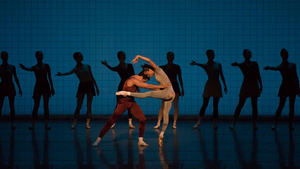Review: REVOLUTION: DANCE ON THE EDGE at Boston Ballet

Boston Ballet's rEVOLUTION: Dance on the Edge features three works by pivotal choreographers which stretch the label 'contemporary' to its breaking point. The three pieces, which all premiered between 1957-1987 may trace through the timeline of progress for commercial ballet in America, but I question if anything a ballet company can do could live up to the streamlined, techno aesthetic toted by their marketing team. The title, with its radical use of capitalization, cuts through the smooth blackness on the cover of the program above a photograph of two dancers in an acrobatic pose in green leotards. Inside the booklet, a geometrically conceived sketch of a dancer invites us to an event called 'Turning Pointe' where we can engage with "leading innovators in the arts, sciences, and industry who are building the future in Boston." Another page announces Boston Ballet's upcoming collaboration with Stephen Galloway, the creative movement director for the Rolling Stones, promising to "shatter expectations of what ballet can be".
The three choreographers represented in rEVOLUTION are all relatively familiar to Boston audiences (perhaps not exactly "on the edge"). Boston Ballet recently programmed George Balanchine's Coppelia, Jerome Robbins' choreography has been revamped in the Bartlett Sher's revivals of Fiddler on the Roof and The King and I which seem to return to the theatre district every other month along with his Fancy Free which Boston Ballet programmed last year, and in addition to William Forsythe's ongoing partnership with Boston Ballet, images of his Choreographic Objects installation at the Institute of Contemporary Art recently flooded Instagram. I am hesitant to say that the three pieces in rEVOLUTION were really radical by today's means or that they really challenged Boston's ideas about ballet, but I am also hesitant to say that these are negative reactions. Nothing wrong with a celebration of classically significant works, but why pretend you are doing anything else? Undoubtedly, an attempt to draw in a younger crowd, but the ballet is generally an intergenerational audience experience as is. Old regulars occupy seats behind children gaping at the opulence of the opera house. Young couples hold hands tentatively on an incredibly sophisticated date. Ballets naturally pull in much more interesting crowds than theatre.
The first piece, Agon, pits the regimented choreography of George Balanchine, executed by dancers whose athleticism is harshly accentuated in their black and white costumes, against the desultory composition by Igor Stravinsky. With a blue projection screen behind them, the ensemble leads a visual study in the compositions of symmetry versus asymmetry, forming with their bodies and the formations of their bodies three-dimensional Rorschach tests in space. The father of American ballet has maintained his reputation for strictness through this gem, but has allowed space for his sly, Russian irreverence; inserting snaps and claps from the dancers in moments of silence (blasphemous!) and allowing moments of whimsy that make the audience chuckle their approval (a collective 'hah' as Soo-Bin Lee shakes her shoulders in time with the music, languid but quick).
Next up, Glass Pieces, the appropriately-titled work by Jerome Robbins set to music composed by Phillip Glass, introduces us to a seemingly infinite loop of dancers in pale pastels ambling across our line of vision in stylized tribute to the metropolitan bustle that only a New York choreographer could so warmly homage. Interpolated soloists in monochrome splashed like water droplets above the ever-shifting sea of dancers. Glass' music is as hypnotic as Stravinsky's is shrill, returning with consistency to familiar chords in unending spirals. Kudos to conductor, Mischa Santora, who allows the two styles to be lasciviously indulged in their contrasting glories.The unanimous crowd favorite highlight of the trio was the second movement of this set, Facades, in which Chrystyn Fentroy and Paul Craig danced, bathed in a soft, golden sidelight, as a line of dancers processed in silhouette behind them. The way the two shared weight fully with each other caged all attention and synched with the gentle lull of the score as a shadow seemed to pass over the stage. The entire sequence was a study in choreography across a single two-dimensional plane. Finally, Robbins lets loose in all of his heteronormative infamy, with an excerpt from Glass' score for the opera, Akhnaten. The men of the company sturdily bound about to accompaniment of blasting brass and reverberating drums before being interrupted by a light-footed gaggle of women, heralded by violins and flutes. The two groups interchange in old-fashioned, pastoral bliss.
Finally, William Forsythe's In the Middle, Somewhat Elevated takes the stage, set to prerecorded techno music by Thom Willems in collaboration with Lesley Stuck. Aside from the music, some transitional moments, and the overall optics of Forsythe's persona (he has flaunted through the worlds of dance, visual art, design, and technology) I found the inclusion of this work after Balanchine and Robbins' to be unnatural and a misstep out of sequence. While he has experimented with ballet in ways that can shatter the industry open (much like it seems Boston Ballet is attempting to market overall), I find his choreography to be entirely uninteresting and uninventive. The ways the dancers moved through space were decidedly unoriginal and lackluster. Perhaps a more accurate progression for the evening would be to include the work of British choreographers Christopher Wheeldon or Matthew Bourne. While neither seems to be gunning for the same edginess as the bad boy wannabe Forsythe, and despite their deeper interest in more conventional balletic material, I believe their choreography is more distinctly inventive and memorable. Conversely, perhaps inclusion of a modern choreographer whose work has drawn from classical ballet (Twyla Tharp or Bill T Jones, maybe) would be more logical. I question if Forsythe has changed the ballet world as significantly as these other artists or if he has just had a good publicist and a few novel ideas.
rEVOLUTION runs at the Opera House through March 8. More info here.
Photo credit Rosalie O'Connor
Reader Reviews

Videos

